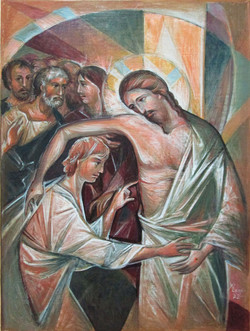
The first day of the week, when the doors were shut where the disciples were assembled for fear of the Jews, came Jesus and stood in the midst...But Thomas, one of the twelve...was not with them when Jesus came. The other disciples therefore said unto him, We have seen the Lord. But he said unto them, Except I shall see in his hands the print of the nails, and put my finger into the print of the nails, and thrust my hand into his side, I will not believe. And after eight days again [Jesus'] disciples were within, and Thomas with them: then came Jesus, the doors being shut, and stood in the midst, and said, Peace be unto you. Then saith he to Thomas, Reach hither thy finger, and behold my hands; and reach hither thy hand, and thrust it into my side: and be not faithless, but believing. And Thomas answered and said unto him, My Lord and my God. Jesus saith unto him, Thomas, because thou hast seen me, thou hast believed: blessed are they that have not seen, and yet have believed. (John 20: 19, 24-29. KJV)
"Doubting Thomas" has become a byword for skeptics who won't believe anything they cannot experience for themselves, but the Disciple Thomas' insistence on putting evidence of the Resurrection to the test offers us proof positive in the Gospel narratives that Jesus, risen from the grave, was no spectral apparition but a real flesh and blood man. In this week's featured icon, Cypriot Artist Charalambos Epaminonda illustrates the moment when the doubtful disciple reaches out to touch the wound in Jesus' side. The Risen Christ extends his arm to embrace Thomas, enfolding him in an unending circle of divine love. (John Kohan)